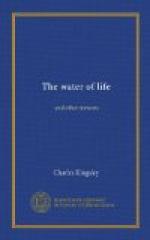Eternally, and for ever, in heaven, says St. John, Christ says, and is, and does, what Isaiah prophesied that He would say, and be, and do,—I am the root and offspring of David, and the bright and morning star. And the Spirit and the Bride (His Spirit and His Church) say, Come. And let him that is athirst, Come: and whosoever will, let him take of the water of life freely. For ever He calls to every anxious soul, every afflicted soul, every weary soul, every discontented soul, to every man who is ashamed of himself, and angry with himself, and longs to live a soberer, gentler, nobler, purer, truer, more useful life—Come. Let him who hungers and thirsts after righteousness, come to the waters; and he that hath no silver— nothing to give to God in return for all His bounty—let him buy without silver, and eat; and live for ever that eternal life of righteousness, holiness, and peace, and joy in the Holy Spirit, which is the one true and only salvation bought for us by the precious blood of Christ, our Lord.
SERMON IX. EZEKIEL’S VISION (Preached before the Queen at Windsor, June 16, 1864.)
Ezekiel i. 1, 26.
Now it came to pass, as I was among the captives by the river of Chebar, that the heavens were opened, and I saw visions of God. And upon the likeness of the throne was the likeness as the appearance of a man.
Ezekiel’s Vision may seem to some a strange and unprofitable subject on which to preach. It ought not to be so in fact. All Scripture is given by Inspiration of God, and is profitable for teaching, for correction, for reproof, for instruction in righteousness. And so will this Vision be to us, if we try to understand it aright. We shall find in it fresh knowledge of God, a clearer and fuller revelation, made to Ezekiel, than had been, up to his time, made to any man.
I am well aware that there are some very difficult verses in the text. It is difficult, if not impossible, to understand exactly what presented itself to Ezekiel’s mind.
Ezekiel saw a whirlwind come out of the north; a whirling globe of fire; four living creatures coming out of the midst thereof. So far the imagery is simple enough, and grand enough. But when he begins to speak of the living creatures, the cherubim, his description is very obscure. All that we discover is, a vision of huge creatures with the feet, and (as some think) the body of an ox, with four wings, and four faces,—those of a man, an ox, a lion, and an eagle. Ezekiel seems to discover afterwards that these are the cherubim, the same which overshadowed the ark in Moses’ tabernacle and Solomon’s temple—only of a more complex form; for Moses’ and Solomon’s cherubim are believed to have had but one face each, while Ezekiel’s had four.
Now, concerning the cherubim, and what they meant, we know very little. The Jews, at the time of the fall of Jerusalem, had forgotten their meaning. Josephus, indeed, says they had forgotten their very shape.




